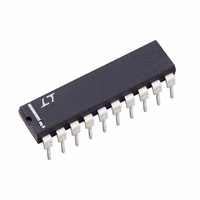LTC1289BCN Linear Technology, LTC1289BCN Datasheet - Page 22

LTC1289BCN
Manufacturer Part Number
LTC1289BCN
Description
IC DATA ACQ SYS 12BIT 3V 20-DIP
Manufacturer
Linear Technology
Type
Data Acquisition System (DAS)r
Datasheet
1.LTC1289CCN.pdf
(28 pages)
Specifications of LTC1289BCN
Resolution (bits)
12 b
Sampling Rate (per Second)
25k
Data Interface
Serial, Parallel
Voltage Supply Source
Dual ±
Voltage - Supply
3V
Operating Temperature
0°C ~ 70°C
Mounting Type
Through Hole
Package / Case
20-DIP (0.300", 7.62mm)
Lead Free Status / RoHS Status
Contains lead / RoHS non-compliant
Available stocks
Company
Part Number
Manufacturer
Quantity
Price
Part Number:
LTC1289BCN#PBF
Manufacturer:
LINEAR/凌特
Quantity:
20 000
LTC1289
Figure 19 shows an FFT plot of the output spectrum for two
tones applied to the input of the A/D. Nonlinearities in the
A/D will cause distortion products at the sum and differ-
ence frequencies of the fundamentals and products of the
fundamentals. This is classically referred to as
intermodulation distortion (IMD).
8. Overvoltage Protection
Applying signals to the analog MUX that exceed the
positive or negative supply of the device will degrade the
accuracy of the A/D and possibly damage the device. For
example this condition would occur if a signal is applied to
the analog MUX before power is applied to the LTC1289.
Another example is the input source is operating from
different supplies of larger value than the LTC1289. These
conditions should be prevented either with proper supply
sequencing or by use of external circuitry to clamp or
current limit the input source. As shown in Figure 20, a
1kΩ resistor is enough to stand off ±15V (15mA for one
only channel). If more than one channel exceeds the
supplies than the following guidelines can be used. Limit
the current to 7mA per channel and 28mA for all channels.
This means four channels can handle 7mA of input current
each. Reducing the ACLK and SCLK frequencies from the
maximum of 2MHz and 1MHz, respectively (see Typical
Peformance Characteristics curves Maximum ACLK Fre-
quency vs Source Resistance and Sample and Hold Acqui-
sition Time vs Source Resistance) allows the use of larger
current limiting resistors. Use 1N4148 diode clamps from
the MUX inputs to V
resistor will not allow the maximum clock speeds to be
used or if an unknown source is used to drive the LTC1289
MUX inputs.
How the various power supplies to the LTC1289 are
applied can also lead to overvoltage conditions. For single
supply operation (i.e., unipolar mode), if V
not tied together, then V
REF
from REF
For dual supplies (bipolar mode) placing two Schottky
diodes from V
power supply reversal from occuring when an input source
22
A
PPLICATI
+
. If this sequence cannot be met, connecting a diode
+
to V
CC
CC
and V
O
is recommended (see Figure 21).
U
CC
–
S
to ground (Figure 22) will prevent
CC
and V
I FOR ATIO
should be turned on first, then
U
–
if the value of the series
W
CC
and REF
U
+
are
is applied to the analog MUX before power is applied to the
device. Power supply reversal occurs, for example, if the
input is pulled below V
below ground which could cause the device not to power
up properly. Likewise, if the input is pulled above V
V
are present on the MUX, the Schottky diodes are not
required if V
Because a unique input protection structure is used on the
digital input pins, the signal levels on these pins can
exceed the device V
–
will be pulled a diode drop above ground. If no inputs
V
IN
Figure 20. Overvoltage Protection for MUX
–
DGND
Figure 22. Power Supply Reversal
is applied first, then V
1k
LTC1289
LTC1289
AGND
CC
V
CH0
DGND
V
CC
REF
–
V
without damaging the device.
LTC1289
–
CC
Figure 21.
+
then V
20
14
AGND
V
V
CC
–
1N4148
CC
1N5817
1N5817
will pull a diode drop
CC
LTC1289 AIF21
22µF
.
3.3V
22µF
3.3V
V
REF
0.1µF
LTC1289 AIF20
22µF
0.1µF
LTC1289 AIF22
3.3V
–3.3V
–3.3V
CC
then
1289fb












